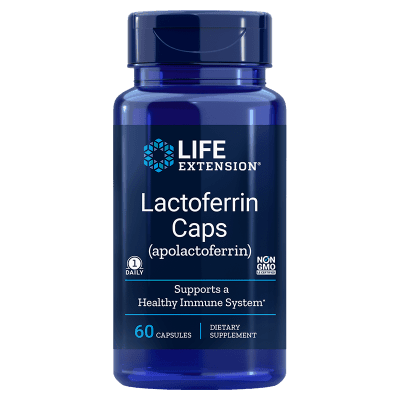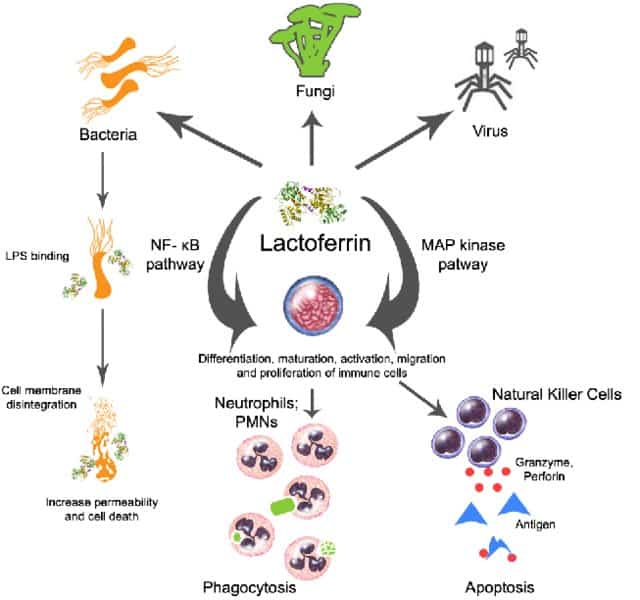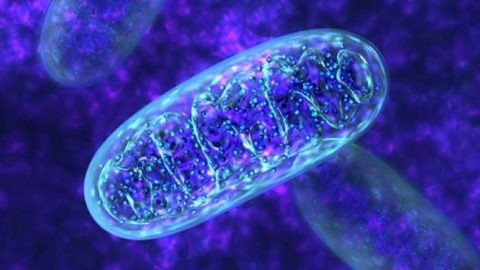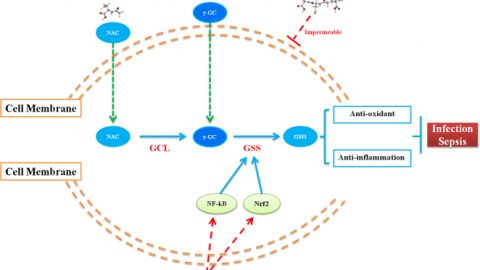20 years ago (how time flies!) I wrote about the impressive anti-viral, anti microbial, anti caner, immune supporting effects of lactoferrin via Life Extension Magazine (also published on BrinkZone of course) as well as a follow up article with additional data further supporting the wide array of benefits of this minor peptide found in whey.
Considering recent events concerning the COVID-19 (Coronavirus) virus, I thought an updated discussion on the anti viral effects of lactoferrin (LF) might be of value. Will taking lactoferrin supplements help prevent or management symptoms specific to this virus? Several recent studies strongly suggest the answer is yes via both in-vitro and in-vivo studies. This study (linked below) found SARS-CoV-2 exposed to lactoferrin at a concentration of 1 mg/mL “… reduced progeny virus yield by up to ∼84,6% in African green monkey kidney epithelial cells (Vero E6) and ∼68,6% in adenocarcinomic human alveolar basal epithelial cells…” Perhaps even more impressive, researchers attempted to identify compounds that were effective against covid looking at various drugs and one supplement, which was lactoferrin, and the results were very impressive. From a write on the study via Medical Press:
“The team validated the 17 candidate compounds in several types of cells, including stem-cell derived human lung cells in an effort to mimic SARS-CoV2 infection of the respiratory tract. Nine showed anti-viral activity at reasonable doses, including lactoferrin, a protein found in human breastmilk that is also available over the counter as a dietary supplement derived from cow’s milk.”
“We found lactoferrin had remarkable efficacy for preventing infection, working better than anything else we observed,” Sexton said. He adds that early data suggest this efficacy extends even to newer variants of SARS-CoV2, including the highly transmissible Delta variant.”
For those who want it in science speak, from the paper, entitled Morphological cell profiling of SARS-CoV-2 infection identifies drug repurposing candidates for COVID-19:
“Notably, we discovered that lactoferrin, a glycoprotein found in secretory fluids including mammalian milk, inhibits SARS-CoV-2 infection in the nanomolar range in all cell models with multiple modes of action, including blockage of virus attachment to cellular heparan sulfate and enhancement of interferon responses. Given its safety profile, lactoferrin is a readily translatable therapeutic option for the management of COVID-19.”
Another study just published, found the simple combination of lactoferrin and the antihistamine Benadryl, demonstrated potent and synergistic anti-viral effects against SARS-CoV-2 and that paper can be read HERE. Furthermore, a study called “Lactoferrin as Antiviral Treatment in COVID-19 Management: Preliminary Evidence” demonstrated very promising results in humans using an oral and intranasal liposomal product with in a group with asymptomatic and mild-to-moderate Covid infections. Below is the abstract:
“Lactoferrin (Lf), a multifunctional cationic glycoprotein synthesized by exocrine glands and neutrophils, possesses an in vitro antiviral activity against SARS-CoV-2. Thus, we conducted an in vivo preliminary study to investigate the antiviral effect of oral and intranasal liposomal bovine Lf (bLf) in asymptomatic and mild-to-moderate COVID-19 patients. From April 2020 to June 2020, a total of 92 mild-to-moderate (67/92) and asymptomatic (25/92) COVID-19 patients were recruited and divided into three groups. Thirty-two patients (14 hospitalized and 18 in home-based isolation) received only oral and intranasal liposomal bLf; 32 hospitalized patients were treated only with standard of care (SOC) treatment; and 28, in home-based isolation, did not take any medication. Furthermore, 32 COVID-19 negative, untreated, healthy subjects were added for ancillary analysis. Liposomal bLf-treated COVID-19 patients obtained an earlier and significant (p < 0.0001) SARS-CoV-2 RNA negative conversion compared to the SOC-treated and untreated COVID-19 patients (14.25 vs. 27.13 vs. 32.61 days, respectively). Liposomal bLf-treated COVID-19 patients showed fast clinical symptoms recovery compared to the SOC-treated COVID-19 patients. In bLf-treated patients, a significant decrease in serum ferritin, IL-6, and D-dimers levels was observed. No adverse events were reported.”
A 2022 review paper entitled “Lactoferrin for COVID-19 prevention, treatment, and recovery” summarized the fact LF works as an anti viral via various mechanisms: “…studies have shown Lf can inhibit various viruses by using distinct mechanisms such as inhibition of viral entry, cytopathic effect, binding, replication, reduction of the severity, and antiviral effect.” Taken in context combined with the bulk of the data – some of which follows below – on lactoferrin, very promising in my view. Perhaps even more important and most impressive as it pertains to covid, a review paper just out suggests LF could address one of the most damaging aspects of Covid, the production of Reactive Oxygen Species (ROS) that may be the root cause of the major complications and deaths from that virus. Study is posted below, and for the full details on iron induced ROS and it’s relevance, see my article HERE.
I strongly suspect that lactoferrin would make an effective adjuvant therapy with other natural anti-viral approaches and medications as outlined in the article linked above. My original article, regarding lactoferrin as an anti-viral peptide, I wrote:
Lactoferrin has been found to both directly and indirectly inhibit several viruses that cause disease in humans. It directly inhibits viruses by binding to viral receptor sites, thus preventing the virus from infecting healthy cells. For example, in vitro studies have found that lactoferrin strongly binds to the V3 loop of the gp120 receptor on HIV-1 and HIV-2, resulting in inhibition of virus-cell fusion and entry of the virus into cells.10 In addition, lactoferrin indirectly kills or inhibits viruses by augmenting the systemic immune response to a viral invasion. It’s interesting to note that there is a systemic deficiency of lactoferrin in people with HIV infection. One study that examined 22 asymptomatic and 45 symptomatic patients with HIV compared to 30 healthy controls found that “levels of plasma lactoferrin are decreased in HIV-1 infected patients in relation to the progression of the disease.”6 Another study found that the lack of lactoferrin (and secretory Iga) found in the oral cavities of people with HIV correlated strongly with the frequent infections in those areas often seen with patients with AIDS.11 Lactoferrin was also found to have “potent” anti-viral effects against the replication of both human HIV and cytomegalovirus (CMV) virus in several in vitro studies with no cytopathic effects on healthy cells.
In addition to HIV and CMV, additional studies have found that lactoferrin inhibits herpes simplex type 1 infection of healthy cells. The latter likely occurs by preventing viral attachment to healthy cells via the blocking of viral proteins and direct immune interactions with natural killer cells, lymphocytes and phagocytes.7,8,9,10
The importance of lactoferrin in viral infections warrants a great deal of further research and use by clinicians. There is little doubt that lactoferrin is a key molecule for the body and the immune system in the fight against viruses and other microbes, and could be an effective supplement for people with viral infections.
In the follow up article, I added:
Previous studies have found lactoferrin to be a powerful inhibitor of a wide range of viruses. Recently, lactoferrin was tested against the deadly hantavirus and was directly compared to the anti-viral drug ribavirin.1 The study found that lactoferrin treated and pretreated cells greatly suppressed hantavirus. Perhaps even more intriguing, it was found that a powerful synergism existed when lactoferrin was combined with ribavirin. The researchers concluded, “These results indicate that lactoferrin has anti-hantaviral activity in vitro and inhibition of virus adsorption to cells, which play an important role in revealing the anti-hantaviral activity of lactorferrin. This paper reports for the first time the anti-hantaviral effect of lactoferrin.”
Note: sources for the above studies mentioned can be located at the the full article pages linked above in the introduction to this article.
2021 Updates:
The role of iron in the pathogenesis of COVID-19 and possible treatment with lactoferrin and other iron chelators. Biomed Pharmacother. 2021 Apr;136:111228
Abstract
Iron overload is increasingly implicated as a contributor to the pathogenesis of COVID-19. Indeed, several of the manifestations of COVID-19, such as inflammation, hypercoagulation, hyperferritinemia, and immune dysfunction are also reminiscent of iron overload. Although iron is essential for all living cells, free unbound iron, resulting from iron dysregulation and overload, is very reactive and potentially toxic due to its role in the generation of reactive oxygen species (ROS). ROS react with and damage cellular lipids, nucleic acids, and proteins, with consequent activation of either acute or chronic inflammatory processes implicated in multiple clinical conditions.
Moreover, iron-catalyzed lipid damage exerts a direct causative effect on the newly discovered nonapoptotic cell death known as ferroptosis. Unlike apoptosis, ferroptosis is immunogenic and not only leads to amplified cell death but also promotes a series of reactions associated with inflammation. Iron chelators are generally safe and are proven to protect patients in clinical conditions characterized by iron overload. There is also an abundance of evidence that iron chelators possess antiviral activities. Furthermore, the naturally occurring iron chelator lactoferrin (Lf) exerts immunomodulatory as well as anti-inflammatory effects and can bind to several receptors used by coronaviruses thereby blocking their entry into host cells. Iron chelators may consequently be of high therapeutic value during the present COVID-19 pandemic.
2020 Updates:
In Vitro Inhibition of SARS-CoV-2 Infection by Bovine Lactoferrin
Abstract
Since its emergence in late 2019, severe acute respiratory syndrome coronavirus 2 (SARS-CoV-2) has been posing a serious threat to public health worldwide as the causative agent of coronavirus disease 2019 (COVID-19). Now distributed in a pandemic pattern, this disease still lacks an effective drug treatment with low toxicity, leading pharmaceutical companies and research labs to work against time to find a candidate molecule to efficiently treat the affected patients. Due to the well-known broad-spectrum antimicrobial activity of the lactoferrin protein, we sought to verify whether its bovine form (bLf) would also be effective in vitro against SARS-CoV-2.
Using an antiviral assay based on quantitative reverse transcription-polymerase chain reaction (qRT-PCR), we found that bLf reduced progeny virus yield by up to ∼84,6% in African green monkey kidney epithelial cells (Vero E6) and ∼68,6% in adenocarcinomic human alveolar basal epithelial cells (A549) at 1 mg/mL, a concentration previously shown to have low cytotoxicity.
Therefore, our preliminary data suggest that bLf has the potential to constitute a biochemical approach to fight the new coronavirus pandemic.
Paper of Interest #2:
In a 2014 review paper – that examined the anti-viral effects of lactoferrin specifically – C R Biol. Potential lactoferrin activity against pathogenic viruses. 2014 Oct;337(10):581-95. – the authors concluded:
“LF has efficacious antibacterial and antiviral activities against a wide range of Gram-positive and Gram-negative bacteria and against both naked and enveloped DNA and RNA viruses. In its antiviral pursuit, LF acts predominantly at the acute phase of the viral infection or even at the intracellular stage, as in hepatitis C virus infection. LF inhibits the entry of viral particles into host cells, either by direct attachment to the viral particles or by blocking their cellular receptors. This wide range of activities may be attributed to the capacity of LF to bind iron and its ability to interfere with the cellular receptors of both hosts and pathogenic microbes.“
That’s an excellent review worth looking up and reading one has the time and inclination.
How to Obtain Lactoferrin
Lactoferrin is a natural constituent of whey protein found in milk. High quality whey protein supplements contain about 0.5% lactoferrin. That means a 20 gram scoop of high quality whey protein isolate provides about 100mg of lactoferrin.
An adequate and cost effective dose of lactoferrin for the adjunctive treatment of disease is estimated to be 300 mg a day. However, during periods of accute immune challenges, 1-2g is likely required to see clinical benefits, but graded dose studies in humans are needed. Such doses will require a lactoferrin supplement.
Lactoferrin Supplements:
There are dietary supplements that provide potent doses of Lactoferrin extracted from whey. When using these supplements, it is important to use a form of lactoferrin called “apolactoferrin” that is depleted of iron. The apolactoferrin form has been shown in studies to provide the benefits of lactoferrin as an antioxidant, and studies show the “apo” form may have additional benefits over that of other forms of lactoferrin.

Conclusion.
Considering how much promise lactoferrin shows as an anti-viral with other potential benefits and no known side effects, I’m surprised and disappointed there’s not more in-vivo human clinical trails published (what else is new when it comes to nutritional supplements, right?!), what does exist however comes up win. Be that as it may, I conclude it’s worth perusing as a non-toxic therapy that may improve resistance to this latest virus as well as others.
Will Brink is the owner of the Brinkzone Blog. Will has over 30 years experience as a respected author, columnist and consultant, to the supplement, fitness, bodybuilding, and weight loss industry and has been extensively published. Will graduated from Harvard University with a concentration in the natural sciences, and is a consultant to major supplement, dairy, and pharmaceutical companies.
His often ground breaking articles can be found in publications such as Lets Live, Muscle Media 2000, MuscleMag International, The Life Extension Magazine, Muscle n Fitness, Inside Karate, Exercise For Men Only, Body International, Power, Oxygen, Penthouse, Women’s World and The Townsend Letter For Doctors.
He’s also been published in peer reviewed journals.
Will is the author of the popular e-books, both accompanied by private members forum access , Bodybuilding Revealed & Fat Loss Revealed.
You can also buy Will’s other books on Amazon, Apple iBook, and Barnes and Noble.








Would I be a to take this with doxycycline? Lactoferrin is not cheap and I don’t want doxycycline to negate it’s effects.
fantastic put up, very informative. I wonder why the other specialists of this
sector do not understand this. You must proceed your
writing. I’m confident, you have a huge readers’ base already!
3 scoops 20 gram a scoop of high quality whey a day with whole milk should do the trick. Feinofibrate 145 mg for 5 days will clear lungs cells from fat which is where the virus thrives in patient with covid-19 .
Israeli scientist have just discovered
I take my whey protein powder, vitamins D3, E, joint, bone, fish oil. Life ext mix. I have been fine all year. I am over 60. I also eat right and exercise. My ancestor gene pool is not that great. So I believe if you stay away from sugar and eat more organic fruits and veggies which I did not see much improvement of during even the highest point of the pandemic, you can really keep your immune system strong.
I have been using whey for years since you first wrote the article about it’s relationship to glutathione for Life Extension Foundation (LEF) magazine. Great to know yet another advantage!
Speaking of COVID19, and LEF, I was wondering if you have any thoughts on LEF’s Cytokine Suppress product? Although it uses a mung bean coat for high vitexin, hawthorn berry can be acquired with equivalent vitexin levels which [possibly] addresses a cytokine storm. And this herb is a well known heart herb.
Great read Will,
What do you think about taking lactoferrin with pycnogenol? or grape seed extract? I already take whey protein, creatine,glycine and a multi vit/mineral.
Thank you!
Joseph Roy